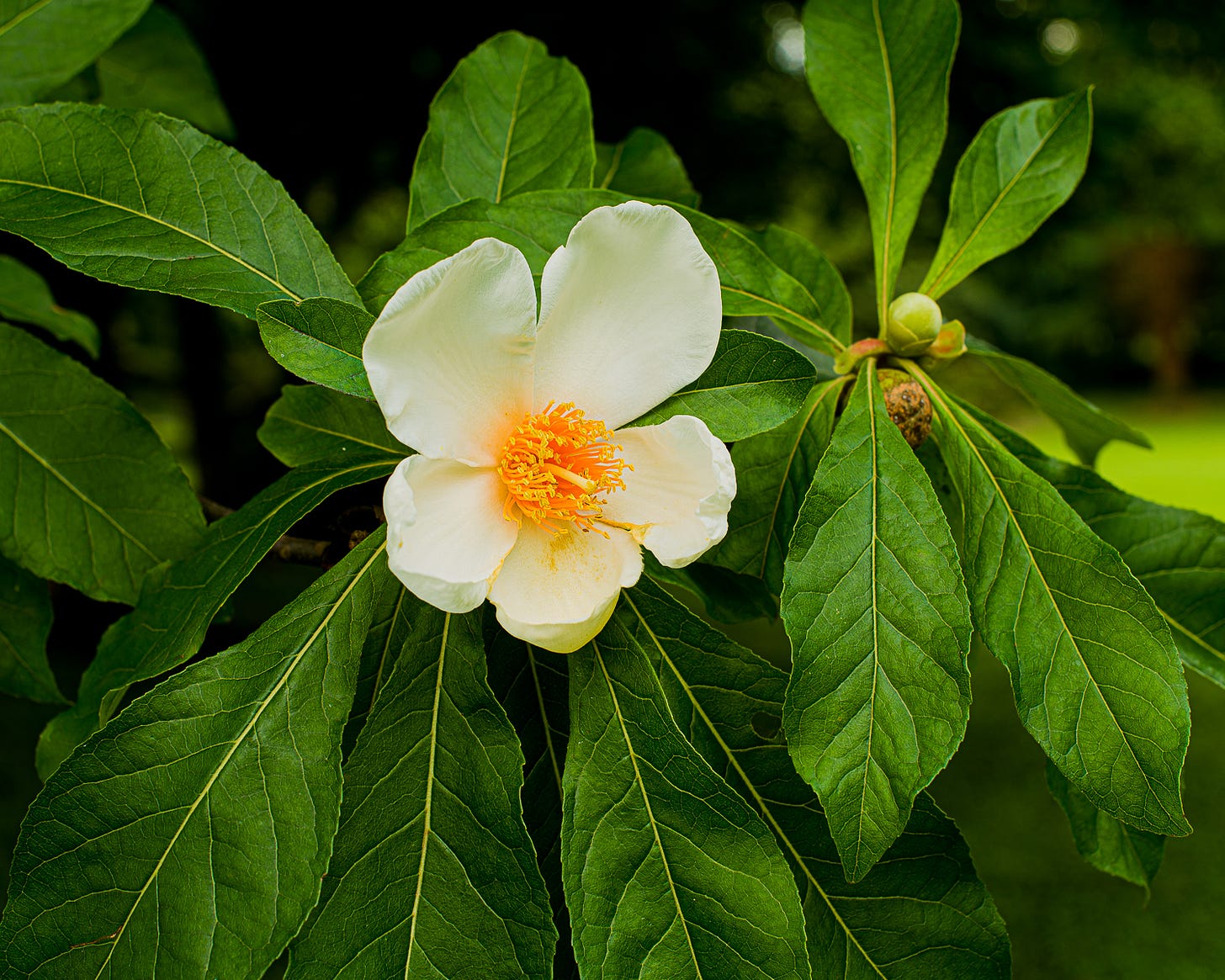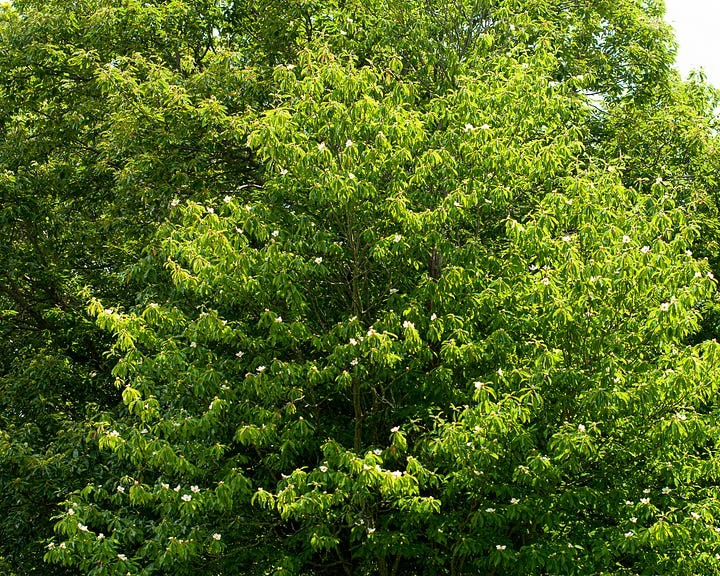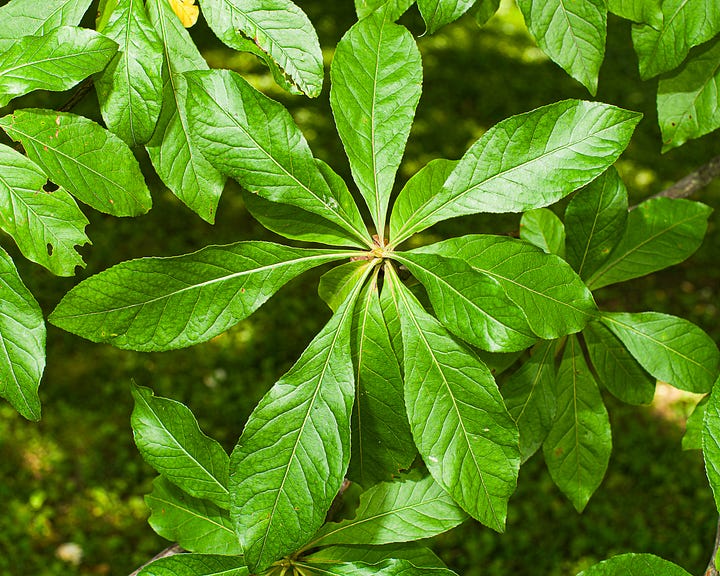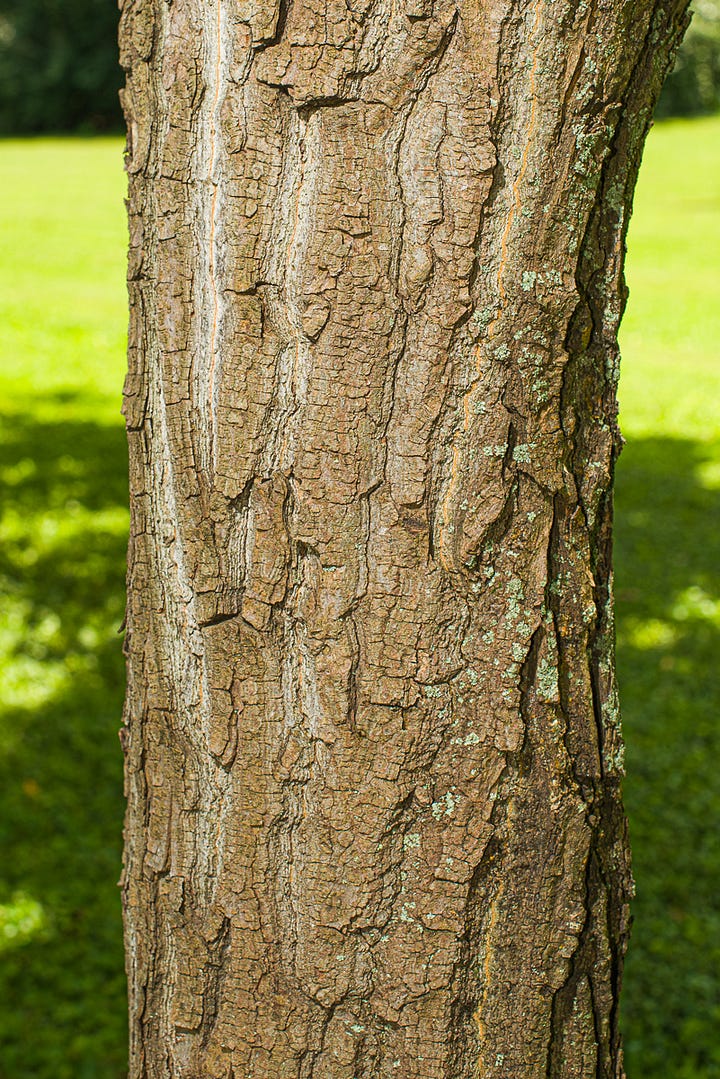Friends, thank you for all the new subscriptions. I will have an update to all subscribers tomorrow. Your support is deeply appreciated. If you are able, we would be grateful for your financial support as well, either as a paid subscriber or through a donation to our Kofi fund. The former will support our newsletter, the latter will support expansion of our services. We are going to try to keep the newsletter free, but need support to do so. Paid subscribers and donors will receive additional benefits including a voice in determining our content, and access to our webinars.
The first time I met a Franklinia tree was captivating. I had planned for this meeting at Cave Hill Cemetery in Louisville, and knew that they would likely be in flower. But seeing this tree for the first time took my breath away.

I see a lot of trees in flower, and some, especially tropical trees, are beautiful and dramatic. But Franklinia is in a realm of its own. The radiant white petals encompass the deep yellow stamens and pistil. The petals are reflectors, lighting up the yellow parts, and the light from the stamens make the petals glow. Behind the glowing flower are the exceptionally deep green leaves that provide contrast to the flowers. Franklinia flowers are not specialized and can accept many pollinators such as bees, beetles, flies, and hummingbirds. What is unusual, though, is the timing of flowering in late summer to early autumn. That’s right, they flower in August-September, unlike any other native tree I can think of. That means that sometimes they are in flower and fall colors at the same time, truly a spectacular site.




Here is what makes Franklinia really stand out: it no longer exists in the wild. Every Franklinia in existence today was propagated from a few seeds and later cuttings of the last surviving trees. Here is the story. Father and son botanists John and William Bartram were charged with exploring the colonies for new plants. John was assigned as Royal Botanist by King George III, and in 1765, they were exploring the Altamaha River in what is now Georgia. They found a small stand of beautiful trees, and William eventually collected seeds from these trees and took them home to Philadelphia. Although William and many others explored the Altamaha in the coming years, they never found a live tree in the wild again. William named the tree Franklinia, Franklinia alatamaha, for the Bartram’s friend Benjamin Franklin, and for the river (misspelled) where they first found it.
In almost 250 years since the Bartram’s found Franklinia on the Altamaha River, no wild tree has been found. And it wasn’t for lack of trying. I spent some time exploring the Altamaha in a small boat and I confess that was constantly surveying the shore, thinking that I might be the one to find a wild tree. No luck for me or anyone else. All the trees growing today are derived as seedlings or cuttings (clones) from William Bartram’s 1777 collection.
I know what your questions might be (let me know if you have others): why did it die, and when are we going to restore it?
The answers are: we don’t know; and never. Let’s consider a plausible history of this tree, consistent with what we do know but with considerable uncertainty.
Franklinia was probably a northern tree, chased south by the climate change that accompanied the last glacial period. Many other trees sought similar refuge, and then moved north as the climate moderated. Franklinia did not. It may have been trapped on the south shore of the Altamaha, which runs east-west, and unable to move north. As the south warmed, an ancient enemy of trees took hold, the deadly fungus Phytophthora cinnamomi. Cotton farming began very early in the slave colony of Georgia and likely caused early land conversion and may have introduced Phytophthora. Today, planted Franklinia does not do well in Georgia, succumbing to Phytophthora. It grows best in northern latitudes, and notably seems to grow best in Philadelphia and nearby.
And here is the problem with restoration: we don’t know anything about the original habitat to which Franklinia was suited. We can’t make rational decisions about where to grow it.
Is the Franklinia story unique? In some respects, but there are many trees in similar circumstances, rare, with small ranges and small populations. Consider Catalina mahogany, Cercocarpus traskiae. Its wild population consists of 6 trees on Santa Catalina Island off the coast of California. Although it is threatened by grazing animals, it has a bigger long-term problem: it readily hybridizes with its very abundant relative, C. betuloides. Catalina mahogany will likely become genetically swamped, with all its progeny eventually being hybrids.
About a third of the world’s trees are in danger of extinction, or 166 thousand species. At the same time, about 9 thousand species have not yet been identified.
Rare trees are always going to be at risk of extinction from one cause or another. We should be more concerned about common trees threatened by our activities: American chestnut, several ash species, etc. We need to devote a lot more energy to helping these trees recover. We will discuss this further in upcoming stories at Our Trees.
What can we do as individuals? Planting native trees, especially rare ones, on our own property is very important. So is contributing your time to tree conservation organizations. Preventing tropical forest destruction is especially important, and the most beneficial effort we can make is to slow or stop eating meat: most tropical forest destruction is due to livestock feeding.
Most importantly, deepen your own appreciation of trees, learn to identify them, and spend time among them.



I didn't know Phytophthora cinnamomi is the likely reason (along with a warming climate) that caused Franklinia trees to die out in their original Georgia habitat. I have wanted a Franklinia for decades, ever since I saw one in flower at a nursery in California, where I once lived. I was finally able to add one to my garden in the NY Hudson Valley this year. The Catskill Native Plant Nursery in Kerhonkson NY propagates and sells them. I'm interested to know that you traveled through the Altamaha valley, because I would dearly love to know what plants grew alongside Franklinia in its original Georgia habitat. Do you have any idea?
Please check out the work of the Alarka Institute in Macon County NC with regard to Frankliniana in WNC.